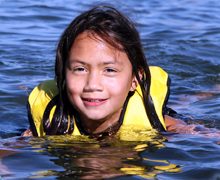Water Safety Tips for Families
You can download this article as a PDF (English, Amharic, Arabic, Chinese, Oromo, Spanish, Somali, Tigrinya, Vietnamese).
 Insist on Adult Supervision
Insist on Adult Supervision
- Always swim with others.
- Set water safety rules.
- Swim in areas with lifeguards.
- Always provide constant attention to children you are supervising in or near water. Stay within arm’s reach of young children and inexperienced swimmers.
- Watch all children and teens swimming or playing in or near water, even if they know how to swim.
- Designate a water watcher when you are in or around water. Never use alcohol or other drugs during water-related activities.
- Remember to supervise young children around water when water play or swimming is not part of your plan.
Wear a Life Jacket
Even if you or your child knows how to swim, children, teens and adults should always wear a U.S. Coast Guard-approved life jacket:
- When on a boat, raft, stand-up paddle board or inner tube
- When swimming in open water like a lake, river or the ocean
- When playing in or near the water and on docks (for young children)
How to Fit Kids for Life Jackets
Learn to Swim
- If you don’t know how to swim well, find someone to teach you. Learn to float and to tread water for at least 10 minutes.
- Make sure your child learns to swim. Upgrade their swimming skills each year.
- Check about lessons at your local pool or life-guarded beach.
Know the Weather and Water Conditions
- Always enter shallow and unknown water feet first.
- Watch for uneven surfaces, river currents, ocean undertow and changing weather.
- Cold water can kill, even on hot summer days. Stay close to shore. Rest if you are cold or tired.
- Obey all safety signs and warning flags.
Know What to Do in an Emergency
- Learn first aid and CPR.
- Bring a cell phone with you or know where to find the nearest phone.
- Dial 911 in an emergency.
- Learn safe ways of rescuing others without putting yourself in danger. Reach out to someone in trouble in the water while holding on to something stable. If you can’t reach them, throw them something that floats.
Learn more about water safety.

